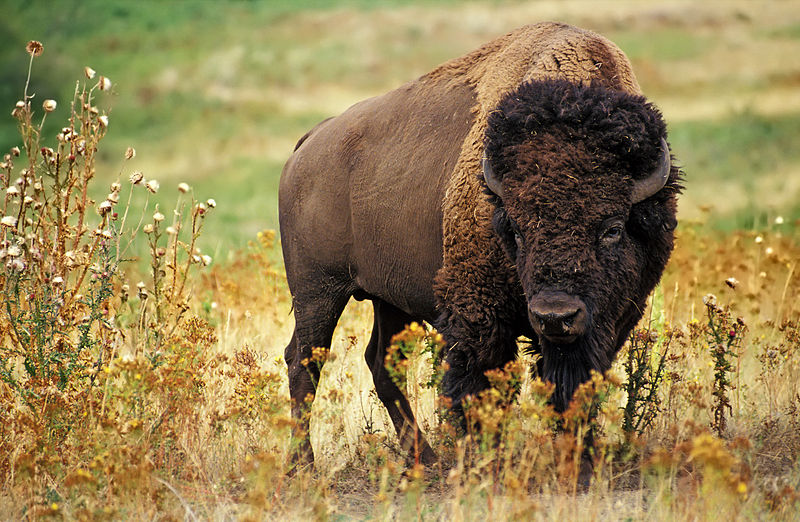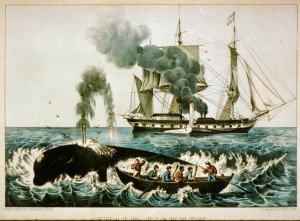In 1872 Yellowstone National Park was established as the first National Park not only in the USA, but in the world. President Ulysses S. Grant signed into law the Yellowstone National Park Protection Act, and so the National Parks were born. Today 59 National Parks exist throughout the United States, covering approximately 51.9 million acres with the goal of maintaining in perpetuity both wildlife and their habitat. Since 1916 the National Park Service (NPS) has been entrusted with the care of these National Parks, and this year they celebrate their centenary. Continue reading “Trump and the future of “America’s best idea.””
What has nature ever done for us?
 Anti-environmentalists and apathists often ask why bother to conserve nature – what does it do for us? Cue enthusiastic green arm-waving and heavy sighs from environmental scientists and ecologists who have faced this attitude their entire careers.
Anti-environmentalists and apathists often ask why bother to conserve nature – what does it do for us? Cue enthusiastic green arm-waving and heavy sighs from environmental scientists and ecologists who have faced this attitude their entire careers.
Nature is undeniably important for the human race – we wouldn’t be here without plants fixing the sun’s energy into carbohydrates and producing oxygen as a by-product, we wouldn’t be able to grow any food to eat without the myriad of organisms which create and maintain the soil, and exposure to nature has numerous psychological and physical benefits for our health. And yet, it is not valued in political decision-making. The environment, particularly the living biological part of it, is a “cross-cutting” issue which means it’s ignored by most government departments, including those that should be valuing it the most (e.g. Department of the Environment, Community and Local Government; Department of Agriculture Food and the Marine; Department of Communications, Energy and Natural Resources). This is because most decision-making is driving by economics.
International momentum has been building for governments, businesses and organisations to begin valuing nature. This doesn’t just mean putting a price on nature – it’s not all about price-tags – but valuing natural capital in the same way that any other capital (financial, human, built etc.) would be valued. And accounting for this capital in decision-making processes at all levels (from individuals up to government policy).
Some countries and individual corporations have made good progress with this (e.g. the UK has a Natural Capital Committee, Coca-Cola and Puma have famously adopted Natural Capital Accounting systems), but there has been little progress in Ireland, until now.
In April, the first Natural Capital Ireland Conference was held, which brought together academics, government representatives from national and local levels, government organisations, NGOs, business and finance and other stakeholders. The point of the meeting was to try and increase understanding of valuing nature nationally, and progress natural capital accounting at all levels.
The report from this conference is now available on the Natural Capital Ireland website (www.naturalcapitalireland.com) and will be launched at the EPA Environment Ireland conference. In addition, the EPA and NPWS have been working with the conference organising committee to create a national Natural Capital Forum.
Whether this will bump the natural environment up the political agenda, and increase people’s interest and enthusiasm for nature remains to be seen… But we need to keep trying to convince people that nature is important, and that not having it is more expensive and economically damaging.
Author: Jane Stout, stoutj[at]tcd.ie
Killing in the Name of Science (Part 1): The Science of Scientific Whaling
“The research reported here involved lethal sampling of minke whales, which was based on a permit issued by the Japanese Government in terms of Article VIII of the International Convention for the Regulation of Whaling. Reasons for the scientific need for this sampling have been stated both by the Japanese Government and by the authors.”
With these words I realised I’d stumbled on that semi-mythical creature, a paper that was the result of scientific whaling. Scientific whaling, if you don’t know, is how the Japanese government justifies hunting whales. Whales have been hunted since time immemorial but due to advances in technology by the mid 20th Century stocks were overexploited to such an extent that many species were pushed to commercial extinction (and possibly, such as in the case of the North Pacific right whale, actual extinction). In 1986 the unprecedented action was taken to ban commercial whaling globally to allow populations to recover. Since then small numbers of whales have continued to be caught, almost exclusively by counties with strong historical ties to whaling such as Norway, Iceland and Japan.
Whales can be caught either commercially or for science. Norway and Iceland whale commercially, selling whale products both locally and internationally through a carefully controlled trade. Japan catches whales for scientific purposes and then sells the meat in accordance with the rules of Article VIII of the Convention. According to the Ministry of Foreign Affairs of Japan,
“The research employs both lethal and non-lethal research methods and is carefully designed by scientists to study the whale populations and ecological roles of the species. We limit the sample to the lowest possible number, which will still allow the research to derive meaningful scientific results.”
The paper that caught my interest is titled “Decrease in stomach contents in the Antarctic minke whale (Balaenoptera bonaerensis) in the Southern Ocean”. There are several ethical questions that the paper raises:
1) Can the samples be obtained without killing the whales?
2) Was the sample limited to “the lowest possible number” that allowed “meaningful scientific results” to be obtained?
3) Was the science worth it?
The first question is arguably the easiest to answer. Investigations of stomach contents commonly requires killing the animal whose stomach contents are desired. While non-lethal methods are available, they are difficult, time-consuming and are most effective on small animals in a captive environment. Thus the killing of whales to examine their stomach contents is not unreasonable.
The second question is harder to answer. Over the course of the 20-year study period, 8,468 whales were killed by the Japanese, an average of 423 minke whales per year. Of those, 5,449 had stomachs containing food, or 279 per year. This sample size is definitely sufficient to give statistically significant results but is it ‘overkill’ (to use the obvious pun)? Looking through my collection of papers on diet analysis, it definitely appears so. A brief survey showed that sample numbers generally range in the low tens (10-50) of specimens. Numbers only went up when sampling commercial species (such as squid or fish) or when opportunities arose. If smaller numbers are accepted by the research community, questions must be asked as to why such high sample numbers were deemed necessary. Of course, if the whales were sampled for other studies and this study was simply an attempt to use the data in as many ways as possible then my concerns are baseless.
The final question is also the most contentious. Who is to say whether the science is worth it or not? The Ministry of Foreign Affairs of Japan said that its research:
“. . . is carefully designed by scientists to study the whale populations and ecological roles of the species. . . The research plan and its results are annually reviewed by the IWC Scientific Committee.”
If it has been assessed by the Japanese government and the IWC (International Whaling Commission) as being necessary, who are we to argue? We need to carefully look at the research being done. On the basis of this paper, I am not convinced. The study uses stomach content analysis to determine that krill availability (the food source of minke whales) has decreased over the last 20 years. Two hypotheses are put forward to explain this decrease: krill populations are being affected by climate change or there is increased interspecific competition for krill as other species increase in population size due to reduced hunting pressure. They conclude:
“Thus, continuous monitoring of food availability as indicated by stomach contents and of energy storage in the form of blubber thickness can contribute important information for the management and conservation under the mandates of both the IWC and CCAMLR of the krill fishery and of the predators that depend on krill for food in the Southern Ocean”
I disagree. They are using stomach contents as a proxy for assessing krill populations, yet it would be far easier and less ethically challenging (something I will return to in my next post) to simply sample the krill. I can see little reason why lethal sampling is required to collect this data, though I’m happy to be persuaded otherwise.
Having not been convinced by this study, I was still willing to believe that scientific whaling was producing good, robust, scientific data that could not be obtained through non-lethal methods. In my search for confirmation or rejection of this hypothesis I came across this report entitled “Scientific contribution from JARPA/JARPA II”. It lists publications that have resulted from Japan’s scientific whaling for the period 1996-2008. In that time, 101 peer-reviewed articles were published and 14,643 whales were killed, 88% of which were minke and 79% of those caught were caught in the Antarctic. Yet despite this seeming wealth of data, the IUCN still considers the Antarctic minke whale to be Data Deficient. Given that most of the papers that have been produced as a result of scientific whaling are related to stock assessment, the lack of an accepted stock level is rather telling in its absence. The rest of the papers seemed to be related to genetic studies, which are possible to do without lethal sampling.
This is, admittedly, a very preliminary survey of the literature resulting from scientific whaling. It can also be claimed that as an ecologist I’m against whaling regardless of the scientific or economic merits. This is not the case. As a disclaimer, I have eaten whale meat while in Norway. It is a sustainable fishery which is carefully monitored. In fact, if I was to feel morally dubious about anything from that meal it would have been my main course of halibut, which has been systematically overfished.
This raises other ethical questions which I hope to address in my next post. However, for now, a conclusion is due. And in my mind it is this: the science that is being produced through scientific whaling does not justify the number of whales being caught. Most of the science can be done through other sampling methods and that which cannot has not been shown to be necessary. Given the costs, the controversy and the decreased ability to sell the meat the case for scientific whaling rests on the quality of the science and ultimately that science is lacking.
Author: Sarah Hearne, hearnes[at]tcd.ie, @SarahVHearne
Image sources: Wiki Commons and Sarah Hearne





